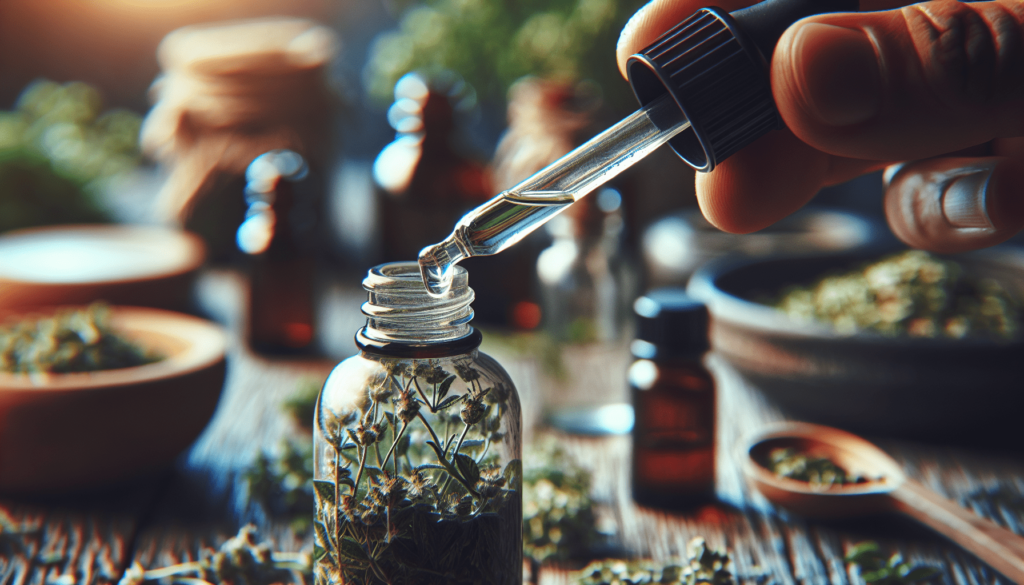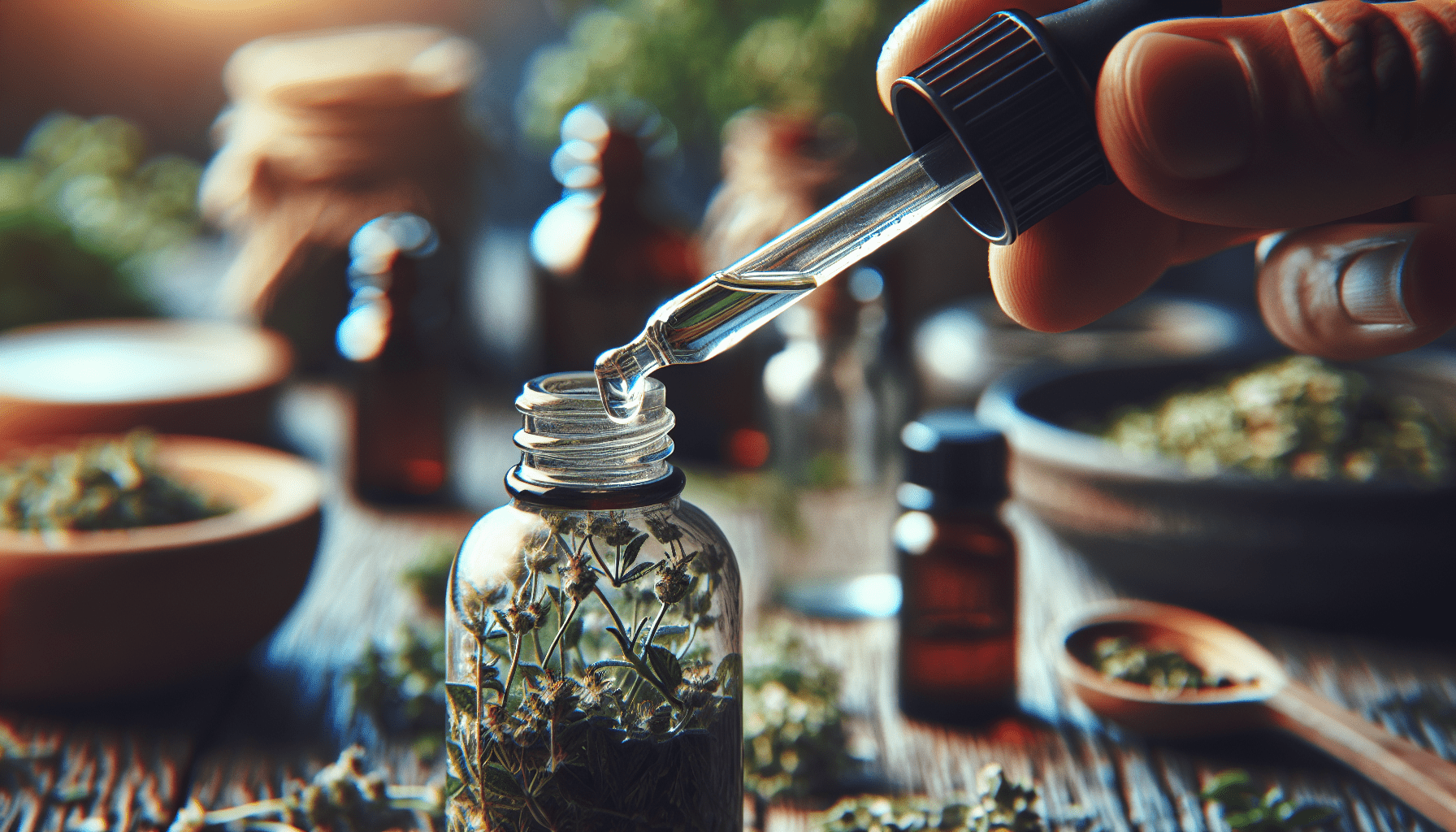So, you’ve got yourself some herbal tinctures, but you’re not a fan of the alcohol content. Whether it’s for personal preference or a dietary restriction, no worries! In this step-by-step guide, we’re going to show you exactly how to remove alcohol from your herbal tinctures so you can enjoy the medicinal benefits without the boozy side effects. Trust us, it’s easier than you might think!
Understanding Herbal Tinctures and Alcohol Content
What are herbal tinctures?
Herbal tinctures are concentrated liquid extracts made from herbs and other plant materials. They are a popular means of harnessing the healing properties of various plants. To create a tincture, the plant material is soaked in a solvent, usually alcohol, to extract the beneficial compounds. Tinctures offer an easy and convenient way to consume and benefit from the medicinal properties of plants.
Why is alcohol used in herbal tinctures?
Alcohol is the most common solvent used in herbal tinctures due to its ability to extract and preserve the active compounds from plants effectively. It acts as a natural preservative, preventing the growth of mold, bacteria, and other microorganisms in the tincture. Alcohol also enhances the absorption of plant compounds into the bloodstream, making the tincture more bioavailable and potent.
Understanding alcohol content in tinctures
Alcohol content in herbal tinctures refers to the percentage of ethanol present in the final product. This information is crucial as it determines the concentration of active compounds and the shelf life of the tincture. The alcohol content can vary depending on the herb being used and the desired potency. Common alcohol percentages in tinctures range from 25% to 90%.
Determining the Need to Remove Alcohol
Reasons why you may want to remove alcohol
There are various reasons why one might want to remove alcohol from herbal tinctures. One common reason is the desire to avoid the potential negative effects associated with alcohol consumption. Some individuals may have religious or personal beliefs that prohibit the use of alcohol. Additionally, certain individuals may be sensitive or allergic to alcohol or may be in recovery from alcohol addiction. In such cases, alcohol-free tinctures provide a suitable alternative.
Effects of alcohol in herbal tinctures
While alcohol is used to extract beneficial compounds, it is important to acknowledge the potential effects it can have on the body. Alcohol is a central nervous system depressant and can cause drowsiness, dizziness, and impaired coordination. It can also interfere with certain medications and may not be suitable for individuals with certain health conditions. For these reasons, some individuals may prefer alcohol-free tinctures.
Types of individuals who may need alcohol-free tinctures
Certain individuals, such as children, pregnant women, and individuals with alcohol sensitivities, may require alcohol-free tinctures. Children are more vulnerable to the effects of alcohol due to their smaller size and developing bodies. Pregnant women should avoid consuming alcohol altogether to protect the health of the developing fetus. Lastly, individuals with alcohol sensitivities or those in recovery from alcohol addiction should avoid even trace amounts of alcohol in their tinctures.

Method 1: Evaporation Technique
Gather necessary supplies
To remove alcohol from a tincture using the evaporation technique, you will need the following supplies:
- Evaporating vessel (such as a wide-mouthed glass jar or ceramic dish)
- Cheesecloth or fine mesh strainer
- Heat source (such as a stovetop or hot plate)
- Thermometer
- Airtight glass container for storing the alcohol-free tincture
Determine the starting alcohol content
Before beginning the evaporation process, it is important to determine the starting alcohol content of the tincture. This information will help you monitor the progress and know when the desired alcohol level has been achieved. A hydrometer or alcoholometer can be used to measure the alcohol content accurately.
Pour the tincture into an evaporating vessel
Carefully pour the herbal tincture into the chosen evaporating vessel, ensuring that it is deep enough to allow for evaporation without overflowing. Leave some headspace to accommodate the decrease in volume during the evaporation process.
Expose the tincture to heat and airflow
Place the evaporating vessel on a heat source and apply gentle heat. It is crucial to use low heat to prevent the degradation of the active compounds in the tincture. Additionally, provide adequate airflow by keeping a fan or open window nearby to facilitate evaporation.
Monitor evaporation progress
Regularly monitor the evaporation progress by measuring the volume of the tincture and checking the alcohol content. As the alcohol evaporates, the tincture’s volume will decrease, and the alcohol content will decrease accordingly. Aim to achieve the desired alcohol content while maintaining the potency of the tincture’s active compounds.
Reconstituting the tincture without alcohol
Once the desired alcohol content is reached, remove the evaporating vessel from the heat source and allow it to cool. If necessary, add a suitable alcohol-free liquid, such as glycerin or apple cider vinegar, to maintain the desired volume and consistency of the tincture. Stir well to ensure proper blending, and then transfer the tincture into an airtight glass container for storage.
Method 2: Simmering Technique
Gather necessary supplies
To remove alcohol from a tincture using the simmering technique, gather the following supplies:
- Double boiler setup (consisting of a heat-resistant glass or stainless steel bowl and a saucepan)
- Cheesecloth or fine mesh strainer
- Thermometer
- Airtight glass container for storing the alcohol-free tincture
Determine the starting alcohol content
Before beginning the simmering process, determine the starting alcohol content of the tincture using a hydrometer or alcoholometer. This will allow you to monitor the progress and ensure that the desired alcohol level is reached.
Prepare a double boiler setup
Fill the saucepan with water and place it on the stove. Bring the water to a simmer, but ensure that it does not reach a rolling boil. Place the heat-resistant glass or stainless steel bowl on top of the saucepan, making sure that it fits securely and does not touch the water.
Simmer the tincture to evaporate alcohol
Carefully pour the herbal tincture into the heat-resistant bowl of the double boiler setup. Allow the tincture to heat gradually, using the gentle heat of the simmering water below. The heat will facilitate the evaporation of alcohol from the tincture, while preserving the beneficial compounds.
Monitor simmering progress
Regularly monitor the simmering progress by checking the volume and alcohol content of the tincture. As the alcohol evaporates, the tincture’s volume will decrease, and the alcohol content will decrease accordingly. Maintain a gentle simmer to prevent overheating and degradation of the tincture.
Reconstituting the tincture without alcohol
Once the desired alcohol content is achieved, carefully remove the heat-resistant bowl from the double boiler setup and allow it to cool. If necessary, add an alcohol-free liquid, such as vegetable glycerin or water, to maintain the desired volume and consistency of the tincture. Stir well to ensure proper blending, and then transfer the tincture into an airtight glass container for storage.
Continue to the next part of the article for remaining methods and conclusion.

